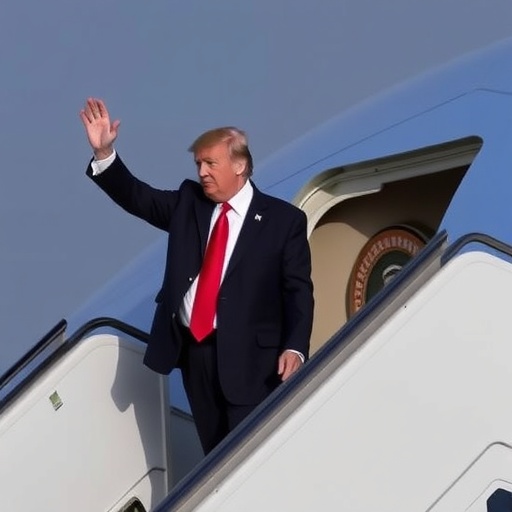Trump Jets Off to Asia for Tense China Trade Talks as U.S. Government Shutdown Hits Record Length
In a bold move amid domestic turmoil, President Donald Trump boarded Air Force One on Monday, heading to Asia for pivotal talks with Chinese President Xi Jinping, even as the U.S. government shutdown stretches into its 35th day, the longest in American history. Federal workers are furloughed without pay, national parks remain closed, and economic ripples are felt nationwide, yet Trump‘s focus turns eastward to tackle the escalating trade war with China.
The trip, which includes stops in Japan, South Korea, and Vietnam before culminating in a summit with Xi in Beijing, underscores the administration’s priority on securing trade concessions and investment deals. Sources close to the White House describe the journey as a high-wire act, balancing global diplomacy with the grinding realities of the government shutdown back home. As Trump departed from Joint Base Andrews, he waved to supporters chanting his name, promising, “We’re going to make great deals for America—big league.”
Shutdown’s Mounting Toll Forces Tough Choices for Trump
The government shutdown, triggered by disputes over border wall funding, has paralyzed federal operations since December 22, 2018. Over 800,000 federal employees are affected, with many resorting to food banks and side gigs to make ends meet. The Treasury Department estimates the shutdown has already cost the economy $11 billion, including lost productivity and delayed IRS tax refunds that could inject billions into consumer spending.
Air traffic controllers, working without pay, have issued stark warnings about safety risks due to understaffing. At major airports like Atlanta’s Hartsfield-Jackson, delays have surged by 20%, according to the Federal Aviation Administration. Coast Guard personnel, too, face unpaid bills, with one anonymous officer telling CNN, “We’re doing our jobs, but families are suffering.”
Trump’s decision to proceed with the Asia trip despite this chaos has drawn bipartisan criticism. House Speaker Nancy Pelosi accused the president of prioritizing foreign jaunts over American workers, stating in a floor speech, “While families go hungry, Mr. Trump globe-trots on taxpayer dollars.” Yet, White House Press Secretary Sarah Sanders defended the move, saying, “Resolving the trade war with China is vital to American jobs and security—it’s not a vacation, it’s leadership.”
Economists warn that the prolonged shutdown could shave 0.13% off U.S. GDP in the first quarter of 2019, per a Moody’s Analytics report. Small businesses near federal sites, like those in Washington D.C., report 30% drops in revenue, with gift shops and restaurants shuttered or barely limping along.
Trade War Flashpoints Dominate Trump’s Asia Itinerary
At the heart of Trump’s Asia excursion is the intensifying trade war with China, which has imposed tariffs on $360 billion of U.S. goods while retaliating against American exports like soybeans and pork. The conflict, sparked by accusations of intellectual property theft and unfair trade practices, has cost U.S. farmers $12 billion in lost exports since 2018, according to the USDA.
Trump’s agenda kicks off in Tokyo, where he’ll meet Japanese Prime Minister Shinzo Abe to discuss a bilateral trade pact. Japan, a key ally, faces its own $41 billion in U.S. tariffs on autos and steel. Analysts expect concessions on currency manipulation clauses in exchange for eased agricultural tariffs. “This could be a blueprint for broader Asia deals,” said Derek Scissors, an Asia economics expert at the American Enterprise Institute.
Next, in Seoul, Trump will confer with South Korean President Moon Jae-in on North Korea denuclearization and trade imbalances. South Korea’s auto industry, hit hard by 25% U.S. steel tariffs, seeks relief. A joint statement is anticipated, potentially including commitments to buy more American LNG amid rising tensions over Huawei’s 5G tech.
The trip’s climax is the bilateral summit with Xi in Beijing, where tariffs on $200 billion of Chinese goods hang in the balance. Trump has hinted at a possible deal, tweeting last week, “China wants to talk—big progress!” However, sticking points remain: Beijing demands the U.S. lift all tariffs, while Washington insists on structural reforms to end forced tech transfers. U.S. Trade Representative Robert Lighthizer, accompanying Trump, has prepared a 150-page negotiation brief, sources say.
Investment deals are also on the table. Trump aims to lure Chinese firms to build factories in the U.S., echoing his “America First” mantra. Foxconn’s scaled-back Wisconsin plant, once touted as a Trump win, serves as a cautionary tale, but optimism persists for sectors like semiconductors and renewables.
Asia-Pacific Allies Brace for Trump’s Demands
Leaders across Asia are preparing for Trump’s trademark hardball style. In Vietnam, hosting the Association of Southeast Asian Nations summit, Prime Minister Nguyen Xuan Phuc eyes U.S. partnerships to counter China‘s South China Sea assertiveness. Trade between the U.S. and Vietnam hit $49 billion in 2018, up 20% year-over-year, but Trump’s visit could accelerate deals in apparel and electronics.
Indian Prime Minister Narendra Modi, though not on the itinerary, has signaled interest in joining talks, frustrated by U.S. revocation of its trade privileges. Meanwhile, Australian PM Scott Morrison welcomes Trump’s focus on countering Chinese influence in the Pacific, where Beijing’s Belt and Road Initiative has invested $1.3 trillion globally.
Security concerns loom large. Trump’s meetings will touch on Huawei bans, with allies like the UK and Canada urged to align against the tech giant. A Pentagon briefing en route highlighted China‘s military buildup, including hypersonic missiles that threaten U.S. carriers in the region.
Environmental groups protest the trip’s carbon footprint—Air Force One’s round-trip emissions equivalent to 1,000 households annually—but Trump dismissed such critiques, saying, “Deals like these save the planet by boosting clean tech trade.”
Federal Workers’ Stories Highlight Shutdown Human Cost
Back home, the government shutdown paints a human portrait of hardship. Smithsonian curator Emily Ramirez, unpaid for five weeks, shared with The Washington Post, “I love my job, but bills don’t wait. We’re rationing groceries.” In Alaska, where federal lands dominate, Native communities report delays in health services, exacerbating opioid crises.
Statistics underscore the strain: The National Park Service has seen 755,000 fewer visitors, costing $70 million in fees. FDA inspections for imported food have dropped 30%, raising food safety alarms. Veterans Affairs hospitals operate skeleton crews, with one VA nurse in Florida telling NPR, “We’re triaging emergencies while worrying about our own mortgages.”
Congressional efforts to end the impasse falter. Senate Majority Leader Mitch McConnell blocks votes without Trump’s approval, prolonging the pain. Bipartisan bills for back pay exist, but immediate relief eludes 9 million contractors also hit hard.
Labor unions like the AFL-CIO rally in D.C., demanding resolution. “This isn’t governance; it’s gridlock,” said President Richard Trumka. Polls show Trump’s approval dipping to 42%, with 53% blaming him for the shutdown, per Gallup.
Global Markets Hinge on Asia Summit Success
Investors watch Trump’s Asia trip with bated breath, as trade war resolutions could jolt markets. The Dow Jones has fluctuated 5% in the past month amid tariff fears, while soybean futures in Chicago plummet 15%. A successful Xi meeting might lift U.S. exports by $20 billion annually, per the Peterson Institute.
Yet risks abound. If talks stall, Phase One deal prospects fade, potentially escalating to 25% tariffs on all Chinese imports. European allies, facing spillover tariffs, urge de-escalation; Germany’s auto sector alone lost €4 billion last year.
Looking ahead, Trump’s return could pivot shutdown negotiations. Advisors whisper of a compromise: $5.7 billion for border security in exchange for reopening government. International pressure from G20 peers might nudge Trump toward flexibility.
Broader implications ripple globally. A thawed U.S.-China relationship could stabilize supply chains for iPhones and EVs, benefiting consumers worldwide. Conversely, prolonged strife risks a global recession, with IMF projections trimming 0.5% off world growth. As Trump lands in Tokyo, the world holds its breath for breakthroughs that could redefine economic alliances for years to come.
(This article draws on reports from Reuters, AP, and Bloomberg, updated as of January 14, 2019.)










